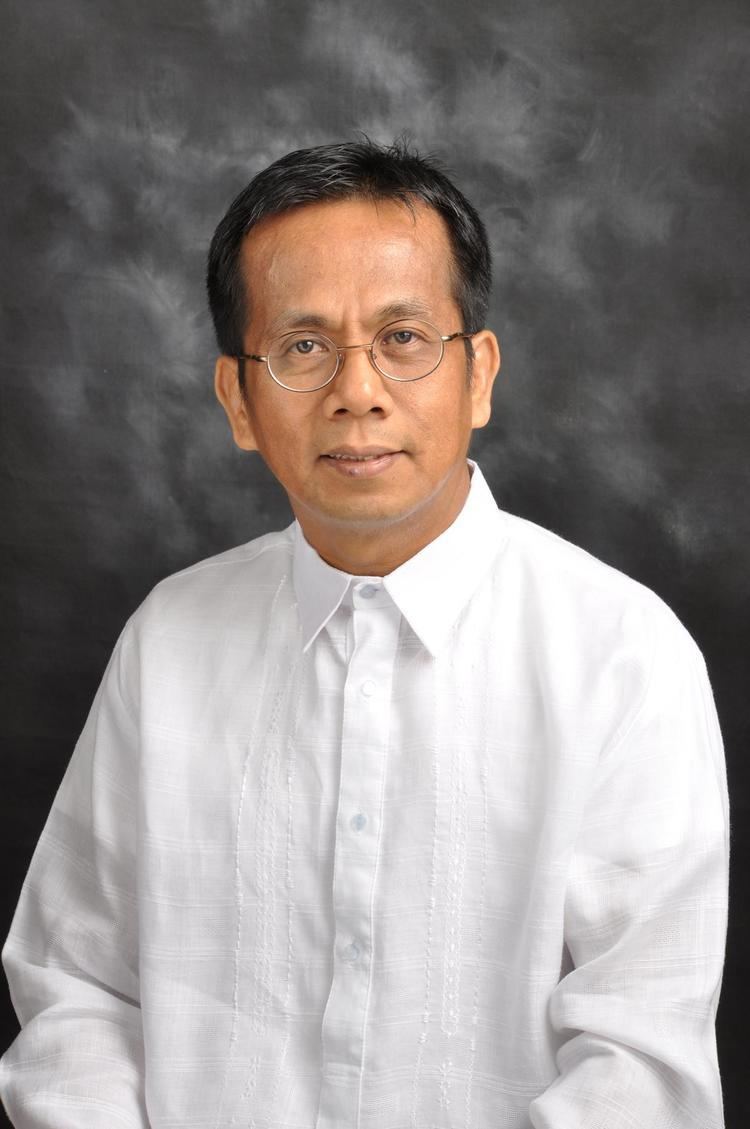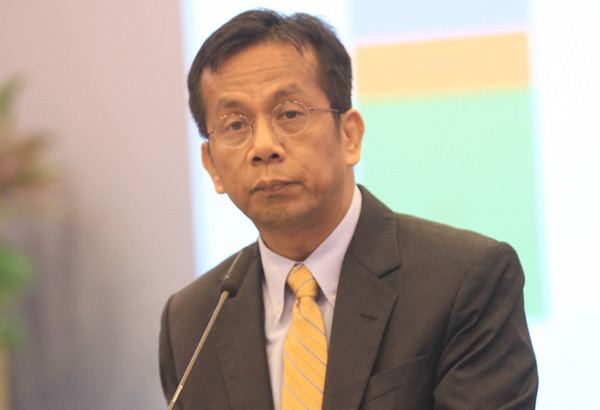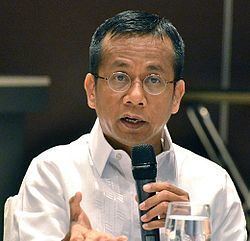Name Arsenio Balisacan | Occupation Economist Nationality Filipino | |
 | ||
Preceded by Cayetano Paderanga, Jr. Alma mater University of Hawaii at Manoa,University of the Philippines Los Banos,Mariano Marcos State University Education University of Hawaii at Manoa Similar Cesar Purisima, Gregory Domingo, Jose Rene Almendras, Cayetano Paderanga - Jr, Albert del Rosario | ||
Socioeconomic planning secretary arsenio balisacan at isom 4
Arsenio M. Balisacan is a Filipino economist and academic serving as the first chairperson of the Philippine Competition Commission (PCC), the country's antitrust agency enforcing prohibitions against anti-competitive business acts and practices. Prior to his appointment in the Commission, he served as the Philippine Socioeconomic Planning Secretary from May 2012 to January 2016 under the administration of President Benigno S. Aquino III. As Socioeconomic Planning Secretary, he concurrently served as Director-General of the National Economic and Development Authority (NEDA), and as Chairman of the Boards of the Philippine Statistics Authority, Philippine Institute for Development Studies, Philippine Center for Economic Development, and Public-Private Partnership Center.
Contents
- Socioeconomic planning secretary arsenio balisacan at isom 4
- NEDA Director General Arsenio Balisacan at 28th PH Economic Briefing
- Early years
- Education
- Early Career as Economist
- Return to the Philippines as an Academic
- Department of Agriculture
- SEARCA
- UP School of Economics
- NEDA
- PCC
- Select Publications
- Sports Long distance runner
- References

Prior to his Cabinet appointment, he was Professor and Dean of School of Economics of the University of the Philippines Diliman and concurrently Executive Director of the Philippine Center for Economic Development.

A holder of PhD in Economics from the University of Hawaii at Manoa, he has been an Academician of the National Academy of Science and Technology (NAST) since 2008.

NEDA Director General Arsenio Balisacan at 28th PH Economic Briefing
Early years
Balisacan was born in Solsona, Ilocos Norte, a remote town located at the foot of the Sierra Madre mountain range. Balisacan’s father was initially a farm tenant tilling fields in a resource-poor, isolated village of the town. When their nun relative convinced his father to take on a janitorial job in Laoag City, they had to leave their farm life behind. In the city, Balisacan, his five other siblings and their parents stayed in a land where they were later evicted. Balisacan said he was in high school when their family was forced out of the property and had to go back to their tiny village at the easternmost part of Ilocos Norte. “It was tough. It was only later on that I realized that we were an informal settler. We were squatting in somebody’s land. [When] I was already in high school, we were evicted from that place, and we had to return to that old town of ours,” Balisacan recalled.
From his primary-school days all the way to his postgraduate studies, Balisacan had to rely on scholarships, grants, and part-time employment as his family was poor. He spent most of his formative years of basic education under the tutelage of Divine Word College of Laoag and completed the last two years of secondary education in Ablan Memorial Academy of Solsona where he graduated as the valedictorian. Balisacan credits his mother’s aunt, Isidra Rivera, who was mayor of the town of Solsona, as his early inspiration in life. “She devoted selflessly her life to this town,” he says. “She had actually very little physical possessions in life, especially when viewed in today’s cadre of local politicians. What she had in abundance was deep respect and love by her people, unblemished credibility and genuine concern for the poor.”
When things got worse, Balisacan’s eldest brother graduated from Divine Word College. Armed with an Accounting degree, Balisacan’s eldest brother was offered a job in Cebu City by Atlas Mining. The job allowed his brother to bring their family to Cebu to live. Balisacan, who was an Agriculture scholar at the Mariano Marcos State University (MMSU), had to stay behind in Batac, Ilocos Norte.
Read more of his early years in these featured articles, "Arsenio M. Balisacan: Resolute at 25" by Cai Ordinario, Business Mirror Anniversary Issue and "Top Philippine Economist to Visit Hawaii" by Belinda Aquino, Hawaii Filipino Chronicle.
Education
Balisacan received a B.S. degree in Agriculture from the Mariano Marcos State University in 1979, graduating magna cum laude. Awarded a graduate scholarship by the Southeast Asian Regional Centre for Graduate Study and Research in Agriculture (SEARCA), he then took up a Master of Science (M.S.) degree in Agricultural Economics from the University of the Philippines Los Baños, from which he graduated in 1982. He received his Ph.D. in Economics from the University of Hawaii at Manoa in 1985
Balisacan received critical support from the East-West Center (EWC) while studying at the University of Hawaii. He served as Research Intern from July 1982 to May 1984 and was a Joint-Doctoral Research Intern from May 1984 to September 1985 under the Resource Systems Institute of EWC. Upon earning his PhD he served as a Research Fellow from October 1985 to March 1986.
Part of his pioneering PhD Dissertation on the political economy of agricultural policy was later published in the Review of World Economics titled, “Public Choice of Economic Policy: The Growth of Agricultural Protection” in 1987.
He was conferred the 2016 Distinguished Alumni Award by the East-West Center (EWC) and East-West Center Alumni Association (EWCAA), the 2006 Distinguished Alumni Award by the University of the Philippines Los Baños Alumni Association, the 2005 Outstanding Alumni Award by the East-West Center Alumni Association Philippines, and the 2004 Most Distinguished Alumnus Award by the Mariano Marcos State University.
Early Career as Economist
As Balisacan wrapped up his PhD studies at the University of Hawaii Manoa, he took up a post as a research fellow at the East-West Center in 1985-1986. He then moved to Washington D.C. in 1986 to serve as an Economist for the World Bank.
Return to the Philippines as an Academic
He came back to the Philippines in 1987 and became an Assistant Professor of Economics at the University of the Philippines Los Banos until 1988 when he moved to UP Diliman and joined the faculty of the University of the Philippines School of Economics, eventually receiving an academic appointment as full professor in 1995.
Balisacan was a recipient of various academic and professional awards. He was elected as academician to the National Academy of Science and Technology (NAST) of the Philippines in 2008. NAST is the country's peer-elected group of select individuals who have made outstanding contributions to science and technology.
As a highly respected academic, he held various positions in academic organizations and advisory groups locally and abroad. He was a member (2011-2015) of the Board of Academic Advisors of the Chinese Center for Agricultural Policy at the Chinese Science Academy and President of the Asian Society of Agricultural Economists (2011-2014). He was Chairman of the Board of Academic Advisors of the Asian Institute of Management’s Center for Bridging Societal Divides (August 2009 to 2012) and member of the Policy Advisory Council of the Australian Centre for International Agricultural Research (June 2009 to May 2012). Balisacan also became president of the Philippine Economic Society - the national learned society for economists - in 2006. He founded and continues to serve as the Editor of the Asian Journal of Agriculture and Development, an internationally refereed journal. He also became an Adjunct Professor at the Australian National University in 2011-2015.
Department of Agriculture
Seconded from UP, he served as Undersecretary for Policy and Planning at the Department of Agriculture Philippines from 2000 to 2001, also serving as Officer-in-Charge at the Agricultural Credit and Policy Council. In this capacity, he served as the Philippine chief negotiator in the World Trade Organization (WTO) Agriculture Negotiations and in various bilateral agriculture negotiations. He returned to this position as Undersecretary for Policy and Planning at the Department of Agriculture for a brief stint in 2003.
SEARCA
Balisacan's abilities as an institution builder are most exemplified by what he has done to bring the Southeast Asian Regional Center for Graduate Study and Research in Agriculture (SEARCA), one of the centers of excellence of the Southeast Asian Ministers of Education Organization (SEAMEO), to new heights as it continues the journey for relevance and excellence as a development institution. Serving as the Center’s Director and Chief Executive in 2003-2009, he restructured the institution to respond to the changing needs, demands, and priorities of its stakeholders, especially the need for institutional capacity-building in the region’s less developed countries in the wake of globalization, environmental degradation, and global climate change. Sound financial management, coupled with innovative approaches to institutional partnerships to reach out to stakeholders, enabled the Center not only to regain lost ground, but also to achieve a respectable level of financial sustainability. Indeed, the work and activities of SEARCA became visible again not only in the region it covers but also to the rest of the world. His accomplishments at SEARCA is summarized in his exit report titled, "Mainstreaming Agriculture in the Development Agenda"
UP School of Economics
Back at UP, in 2010, Balisacan was appointed Dean of the School of Economics at the University of the Philippines Diliman. As Dean, he concurrently served as Executive Director of the Philippine Center for Economic Development and Chairman of the UPecon Foundation Inc.
NEDA
Balisacan held these academic posts until he was seconded from UP to the National Economic and Development Authority (NEDA) when Philippine President Benigno S. Aquino III asked him to serve as Secretary of Socioeconomic Planning. Aquino signed his appointment papers on May 10, 2012, and was confirmed by the bicameral Committee on Appointments of the Philippine Congress on February 6, 2013.
As Secretary of Socioeconomic Planning and Director-General of NEDA, Secretary Balisacan was tasked to address the critical constraints that make economic growth slow, uneven, and exclusive to certain segments of the Philippine society.
Concurrent to his role as Secretary of Socioeconomic Planning and Director-General of NEDA, he served as Board Chairman of the Philippine Institute for Development Studies and the Philippine Center for Economic Development; the first Governing Board Chairperson of the Public-Private Partnership Center of the Philippines; and the first Board Chairperson of the Philippine Statistics Authority (which combines the National Statistical Coordination Board, the National Statistics Office, the Department of Agriculture's Bureau of Agricultural Statistics, the Department of Labor and Employment's Bureau of Labor and Employment Statistics, and the Philippine Statistical Research Institute.)
At these key positions, Secretary Balisacan was able to influence policies, programs, and projects to facilitate inclusive economic growth, employment creation, and poverty reduction. He was partly to be commended for the recent remarkable performance of the Philippine economy. In 2010 to 2015, the six-year average growth of the Philippine economy was 6.2 percent, the country’s fastest in 40 years. Today, the Philippine economy remains one of the best-performing developing economies in Asia.
PCC
Following the passage of the Philippine Competition Act (PCA) by Congress in 2015, President Benigno S. Aquino III formed the Philippine Competition Commission (PCC) in January 2016, appointing Balisacan to serve as its first Chairperson. PCC is an independent quasi-judicial body created to promote and maintain market competition by regulating anti-competitive conduct and practices. The main role of the PCC is to advance efficiency in the market for the benefit of the consumers, businesses, and the economy.
Select Publications
Sports: Long-distance runner
Balisacan regularly runs 15 to 25 kilometers on weekends and 10 kilometers at least twice on weekdays, and only his government position keeps him from doing it more frequently. He has completed numerous half, three-quarter, and full 42K marathon events, both locally and abroad. His last 42K was in Honolulu in 2012. It was in Hawaii where he discovered the sport of long-distance race, three decades ago. “I acquired the running habit while I was working on my doctoral degree [in Economics] in Hawaii. That was in the early 1980s,” he says. “My runs then were limited to the 10K to 21K distances. My really first full marathon, the 42K variety, came much later, in the late 1980s when I joined the PAL International Marathon in Manila,” he says. “I never left long-distance running [over 10K] since then, though there were several years when I skipped 42K marathons,” he says.
